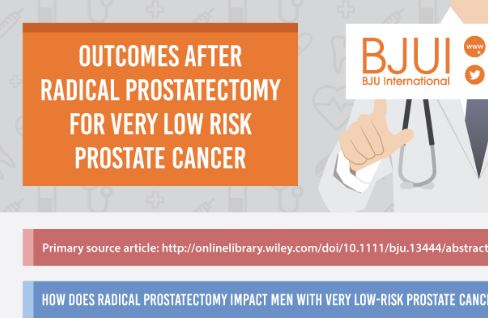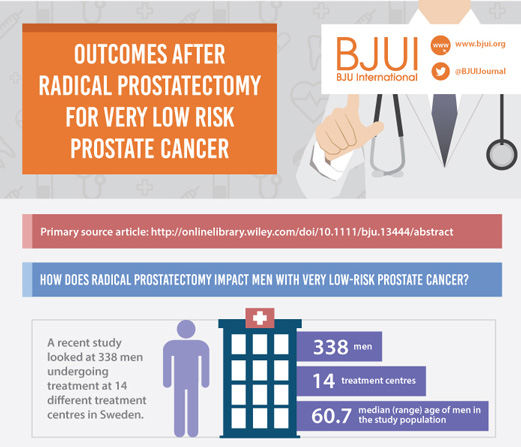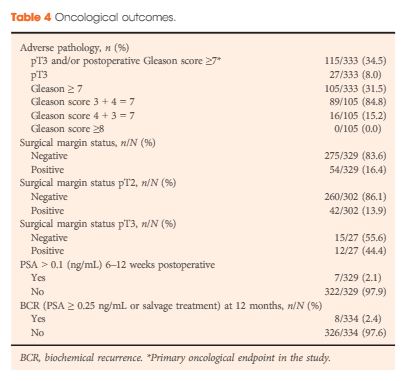Posts
Article of the Week: LAPPRO trial – Oncological and Functional Outcomes 1 Year after RP for Very-Low-Risk PCa
Every Week the Editor-in-Chief selects an Article of the Week from the current issue of BJUI. The abstract is reproduced below and you can click on the button to read the full article, which is freely available to all readers for at least 30 days from the time of this post.
In addition to the article itself, there is an accompanying editorial written by a prominent member of the urological community. This blog is intended to provoke comment and discussion and we invite you to use the comment tools at the bottom of each post to join the conversation.
Finally, the third post under the Article of the Week heading on the homepage will consist of additional material or media. This week we feature a video from Dr. Stefan Carlsson, Dr. Anna Wallerstedt and Dr Rodolfo Sanchez, discussing their paper.
If you only have time to read one article this week, it should be this one.
Oncological and functional outcomes 1 year after radical prostatectomy for very-low-risk prostate cancer: results from the prospective LAPPRO trial
*, Fredrik Jaderling†, *, ‡, §
, ¶, **, ††, §, ‡‡ and ‡,§§
*Department of Molecular Medicine and Surgery, Section of Urology, Karolinska Institutet, †Department of Molecular Medicine and Surgery, Section of Radiology, Karolinska Institutet, ‡Department of Oncology and Pathology, Division of Clinical Cancer Epidemiology, Karolinska Institutet, Stockholm, §Department of Urology, Institute of Clinical Sciences, Sahlgrenska Academy at the University of Gothenburg, ¶Faculty of Nursing, School of Health Sciences, University of Iceland, Iceland, **Department of Surgery (Urology Service), Memorial Sloan Kettering Cancer Center, New York, NY, USA, ††Department of Urology, Skane University Hospital, Lund University, Lund, ‡‡ Department of Surgery, Institute of Clinical Sciences, Sahlgrenska Academy at the University of Gothenburg, and §§Division of Clinical Cancer Epidemiology, Department of Oncology, Institute of Clinical Sciences, Sahlgrenska Academy at the University of Gothenburg, Gothenburg, Sweden
Click on image for full size infographic
Objectives
To analyse oncological and functional outcomes 12 months after treatment of very-low-risk prostate cancer with radical prostatectomy in men who could have been candidates for active surveillance.
Patients and Methods
We conducted a prospective study of all men with very-low-risk prostate cancer who underwent radical prostatectomy at one of 14 participating centres. Validated patient questionnaires were collected at baseline and after 12 months by independent healthcare researchers. Biochemical recurrence (BCR) was defined as prostate-specific antigen (PSA) ≥0.25 ng/mL or treatment with salvage radiotherapy or with hormones. Urinary continence was defined as <1 pad changed per 24 h. Erectile function was defined as ability to achieve erection hard enough for penetration more than half of the time after sexual stimulation. Changes in tumour grade and stage were obtained from pathology reports. We report descriptive frequencies and proportions of men who had each outcome in various subgroups. Fisher’s exact test was used to assess differences between the age groups.
Results
Of the 4003 men in the LAPPRO cohort, 338 men fulfilled the preoperative national criteria for very-low-risk prostate cancer. Adverse pathology outcomes included upgrading, defined as pT3 or postoperative Gleason sum ≥7, which was present in 35% of the men (115/333) and positive surgical margins, which were present in 16% of the men (54/329). Only 2.1% of the men (7/329) had a PSA concentration >0.1 ng/mL 6–12 weeks postoperatively. Erectile function and urinary continence were observed in 44% (98/222) and 84% of the men (264/315), respectively, 12 months postoperatively. The proportion of men achieving the trifecta, defined as preoperative potent and continent men who remained potent and continent with no BCR, was 38% (84/221 men) at 12 months.
Conclusions
Our prospective study of men with very-low-risk prostate cancer undergoing open or robot-assisted radical prostatectomy showed that there were favourable oncological outcomes in approximately two-thirds. Approximately 40% did not have surgically induced urinary incontinence or erectile dysfunction 12 months postoperatively. These results provide additional support for the use of active surveillance in men with very-low-risk prostate cancer; however, the number of men with risk of upgrading and upstaging is not negligible. Improved stratification is still urgently needed.
Editorial: Management Dilemmas in Low-Risk Prostate Cancer
Prostate cancer is the most commonly diagnosed solid organ tumour and the second leading cause of cancer death in men in the USA. The exact path of these tumours from inception to metastasis is unclear; the same can also be said for those tumours that remain indolent. The varying genetic signatures of these tumours is the underlying determinant of the outcomes of these cancers and therein lies the key to selecting patients that do and do not need treatment for their prostate cancers. Most low-risk tumours are relatively indolent; however, some low-risk tumours have the potential to metastasise and cause mortality. The problem is that currently we do not have the ability to accurately and confidently determine the tumour’s individual risk profiles.
In the recent LAPPRO trial (LAParoscopic Prostatectomy Robot Open – a randomised, open trial of radical prostatectomy (RP) with or without lymph node dissection as part of a prospective, non-randomised, open trial comparing robot-assisted laparoscopic and open RP), the authors reported the RP results of patients with very-low-risk prostate cancer in a population-based study from Sweden compiling the results of open and laparoscopic RP over 14 centres of varying experience [1]. They reported pathological upgrading in 35% of patients and PSA recurrence in 2.1%. Functional outcomes at 1 year featured urinary continence levels of 84% and sexual potency of 44%. The overall trifecta rate at 1 year was 38%. What is important to note is that only 56% had optimal erectile function preoperatively (Sexual Health Inventory for Men score >21) and that it is unknown which patients received a full nerve preservation. Also the amount of postoperative continence and potency rehabilitation is unknown.
The results of the LAPPRO trial are not too dissimilar to data from the Medicare database publications on RP, which also take into account large populations of patients operated on at multiple institutions with variable surgical experience and volume [2]. The challenge with interpreting these data is that they often are quite variable based upon the preoperative status of the patient, type of surgery performed, surgeon experience, and institutional volumes [3]. If you compare the Medicare data or LAPPRO trial outcomes to large-volume single-surgeon series you often will see wide variances in outcomes favouring the single-surgeon experience. Single-surgeon and large-volume series have reported better outcomes often due to improved surgical experience, techniques, and outcomes overall [4].
Active surveillance is usually the primary choice for management of low- and very-low-risk prostate cancer lesions. However, some patients do still chose to undergo surgery due to personal choice, often related to the uncertainty associated with the diagnosis and the unknown risk of progression [5]. One would assume that low-risk tumours have a low risk of progression and metastasis; however, this is not always the case due to the varying genetic signature of the individual tumours. Also, recent studies have shown that in patients diagnosed with low-risk prostate cancer 30–50% have non-low-risk disease harbouring intermediate- or high-risk prostate cancer instead [1, 6]. This uncertainty on the part of the patient and physician can cause anxiety in patients and sometime influence their decision for treatment [7].
One would assume that patients with low- and very-low-risk patients are ideal candidates for the trifecta due to low tumour aggressiveness and volume. However, many factors influence patient outcome beyond the characteristics of the tumour. Preoperative features such as co-morbidities and pre-existing sexual dysfunction or incontinence are influential. Operative and postoperative factors include: surgeon experience, institutional volume, patients body habitus, number of prior biopsies, the ability to fully spare the nerves, and various other challenges during surgery. These are all variables that must be considered when projecting the success of surgical intervention.
While the results of surgery in the LAPPRO trial were not encouraging for surgery, we do have to take the results in context and not apply them broadly or globally without some thought. The results are blurred by combining open and laparoscopic RP, many patients were not optimal candidates’ preoperatively for the trifecta, many did not have a full nerve preservation and also many different institutions with varying levels of surgeon experience are analysed. This population was also ‘captive’, as they had to choose surgeons in their own locality, these ‘local’ surgeons may not have had the necessary experience or technique to achieve optimal outcomes. The conclusion that can be drawn is that if you sample a broad population of surgeons then the results are often quite poor due to the varying levels of skill of the surgeon and the varying level of surgical volume and experience. What the patients should glean from this is the fact that they should consider active surveillance for these types of tumours to avoid the associated morbidity. In addition, if they were to seek therapy they should select centres with higher surgical experience and proven outcomes.
For those patients that have low-risk tumours and seek treatment; judicious counselling of expectations must be performed by their healthcare advocate. Both the patient and physician must take the responsibility in making the correct assumptions and decisions. The physician must re-emphasise the available data and the low likelihood of progression in these tumours adding some caution from the fact that some of these may be upgraded. Patients must be given accurate data in the correct context. Most patients who have treatment for prostate cancer whether it be radiation, ablation or removal have a high chance of some deficit in the quality of life, functional recovery of urinary continence, and sexual potency. Educating the patient and managing realistic expectations is often the most important factor in patient satisfaction. Patients must take into account their own preoperative medical and functional status to properly stratify expectations.
If these patients after appropriate counselling are still intent to undergo surgery they should consider seeking centres with high-volume and individualised surgeons with proven quality outcomes. Large-volume single-surgeon series do show improvements in the trifecta outcomes [4]. However, none have shown perfect trifecta rates. No matter what method of treatment patients chose there would be some varying level of loss of functional outcome. The balance between cancer progression and quality of life must be weighted. For low-risk patients, we need to have a better road map of the genetic signatures of their tumour and only then will we be able to confidently tell our patients who will and who will not have the potential to harbour high-risk disease and potentially have mortality from the tumour. Until we are able to confidently deliver this information to the patient, many with low-risk disease will still seek treatment and endanger their quality of life. The recent increase in the availability of biomarkers to examine prostate biopsy specimens for risk stratification is encouraging, yet still in its infancy. Further study of these biomarkers will enhance our ability to read the genetic signature of prostate cancers at an early state and more appropriately risks stratify our patients.
The LAPPRO trial supports active surveillance as the primary choice for low- and very-low-risk tumours. However, their results are exclusive to their patient population and level of surgical experience. A similar trial with a high-volume experienced surgeon would undoubtedly show more optimistic results. Managing reasonable expectations, risk stratification, and picking expertise and experience, often makes the difference between a good and poor outcome.
*† and *†
*Global Robotics Institute, Florida Hospital Celebration Health, and †University of Central Florida School of Medicine, Orlando, FL, USA
References
1 Carlsson S, Jaderling F, Wallerstedt A et al. Oncological and functional outcomes 1 year after radical prostatectomy for very-low-risk prostate cancer: results from the prospective LAPPRO trial. BJU Int 2016; 118: 205–12
2 Barry MJ, Gallagher PM, Skinner JS, Fowler FJ Jr. Adverse effects of robotic-assisted laparoscopic versus open retropubic radical prostatectomy among a nationwide random sample of Medicare-age men. J Clin Oncol 2012; 30: 513–8
3 Patel VR, Abdul-Muhsin HM, Schatloff O et al. Critical review of ‘pentafecta’ outcomes after robot-assisted laparoscopic prostatectomy in high-volume centres. BJU Int 2011; 108: 1007–17
4 Patel VR, Coelho RF, Chauhan S et al. Continence, potency and oncological outcomes after robotic-assisted radical prostatectomy: early trifecta results of a high-volume surgeon. BJU Int 2010; 106: 696–702
5 Simpkin AJ, Tilling K, Martin RM et al. Systematic review and meta-analysis of factors determining change to radical treatment in active surveillance for localized prostate cancer. Eur Urol 2015; 67: 993–1005
6 El Hajj A, Ploussard G, de la Taille A et al. Analysis of outcomes after radical prostatectomy in patients eligible for active surveillance (PRIAS). BJU Int 2013; 111: 53–9
7 Van den Bergh RC, Essink-Bot ML, Roobol MJ et al. Anxiety and distress during active surveillance for early prostate cancer. Cancer 2009; 115: 3868–78
Video: LAPPRO trial – Oncological and Functional Outcomes 1 Year after RP for Very-Low-Risk PCa
Oncological and functional outcomes 1 year after radical prostatectomy for very-low-risk prostate cancer: results from the prospective LAPPRO trial
*, Fredrik Jaderling†, *, ‡, §
, ¶, **, ††, §, ‡‡ and ‡,§§
*Department of Molecular Medicine and Surgery, Section of Urology, Karolinska Institutet, †Department of Molecular Medicine and Surgery, Section of Radiology, Karolinska Institutet, ‡Department of Oncology and Pathology, Division of Clinical Cancer Epidemiology, Karolinska Institutet, Stockholm, §Department of Urology, Institute of Clinical Sciences, Sahlgrenska Academy at the University of Gothenburg, ¶Faculty of Nursing, School of Health Sciences, University of Iceland, Iceland, **Department of Surgery (Urology Service), Memorial Sloan Kettering Cancer Center, New York, NY, USA, ††Department of Urology, Skane University Hospital, Lund University, Lund, ‡‡ Department of Surgery, Institute of Clinical Sciences, Sahlgrenska Academy at the University of Gothenburg, and §§Division of Clinical Cancer Epidemiology, Department of Oncology, Institute of Clinical Sciences, Sahlgrenska Academy at the University of Gothenburg, Gothenburg, Sweden
Objectives
To analyse oncological and functional outcomes 12 months after treatment of very-low-risk prostate cancer with radical prostatectomy in men who could have been candidates for active surveillance.
Patients and Methods
We conducted a prospective study of all men with very-low-risk prostate cancer who underwent radical prostatectomy at one of 14 participating centres. Validated patient questionnaires were collected at baseline and after 12 months by independent healthcare researchers. Biochemical recurrence (BCR) was defined as prostate-specific antigen (PSA) ≥0.25 ng/mL or treatment with salvage radiotherapy or with hormones. Urinary continence was defined as <1 pad changed per 24 h. Erectile function was defined as ability to achieve erection hard enough for penetration more than half of the time after sexual stimulation. Changes in tumour grade and stage were obtained from pathology reports. We report descriptive frequencies and proportions of men who had each outcome in various subgroups. Fisher’s exact test was used to assess differences between the age groups.
Results
Of the 4003 men in the LAPPRO cohort, 338 men fulfilled the preoperative national criteria for very-low-risk prostate cancer. Adverse pathology outcomes included upgrading, defined as pT3 or postoperative Gleason sum ≥7, which was present in 35% of the men (115/333) and positive surgical margins, which were present in 16% of the men (54/329). Only 2.1% of the men (7/329) had a PSA concentration >0.1 ng/mL 6–12 weeks postoperatively. Erectile function and urinary continence were observed in 44% (98/222) and 84% of the men (264/315), respectively, 12 months postoperatively. The proportion of men achieving the trifecta, defined as preoperative potent and continent men who remained potent and continent with no BCR, was 38% (84/221 men) at 12 months.
Conclusions
Our prospective study of men with very-low-risk prostate cancer undergoing open or robot-assisted radical prostatectomy showed that there were favourable oncological outcomes in approximately two-thirds. Approximately 40% did not have surgically induced urinary incontinence or erectile dysfunction 12 months postoperatively. These results provide additional support for the use of active surveillance in men with very-low-risk prostate cancer; however, the number of men with risk of upgrading and upstaging is not negligible. Improved stratification is still urgently needed.






